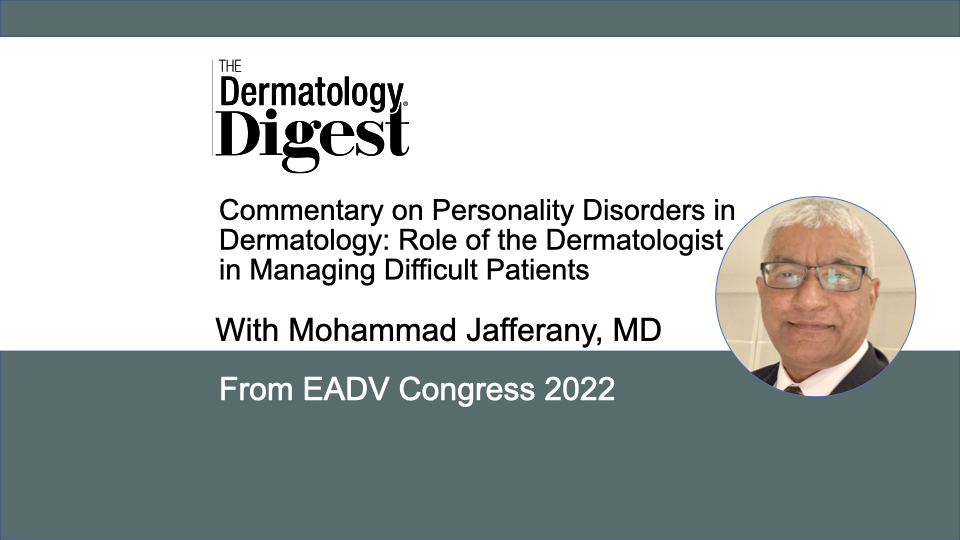Dr. Mohammad Jafferany discusses common personality disorders that dermatologists are likely to encounter, including tips for managing these often-difficult patients.
Mohammad Jafferany, MD, FAPA, MCPS (Derm.), Professor of Psychodermatology, Psychiatry and Behavioral Sciences, College of Medicine (East Campus), Central Michigan University, Saginaw, Michigan
“The personality is an inflexible, pervasive, and enduring pattern, which cannot be changed. We obviously cannot change the patient’s personality, but if we understand the [underlying] psychological conflicts, patients’ behaviors, and presenting patterns, it would help us formulate a care plan and treatment strategies that could be more helpful for the patient’s benefits and treatment compliance,” said Mohammad Jafferany, MD, who presented “Personality Disorders in Dermatology: Role of the Dermatologist in Managing Difficult Patients,” during the 31st European Academy of Dermatology and Venereology (EADV) Congress 2022 in Milan, Italy.
A personality disorder is defined by an enduring pattern that deviates markedly from the expectation of the individual’s culture, said Dr. Jafferany.
“From a definition standpoint, there are four major elements we need to consider: cognition, affectivity, interpersonal functioning, and impulse control. For a personality disorder to be diagnosed, two out of these four must be present.”
Patients who have personality disorders are always difficult patients that any dermatologist can encounter, he said.
“The role of the dermatologist in these cases is first to recognize the personality disorder and understand the underlying psychological conflicts and carefully observe patients’ behavior and presenting pattern. The dermatologist should be nonconfrontational, nonjudgmental, while being patient and accommodating to those patients. That is the whole point of forming a good bond and rapport with the patient.”
The role of the dermatologist, however, is not to diagnose patients who they believe have personality disorders, said Dr. Jafferany.
“As a dermatologist, you are not supposed to diagnose a patient with a personality disorder. This might lead to long-term problems like litigation…. Be very careful in your documentation in the patient’s chart. You can mention the symptoms that the patient has in detail but try to refrain from putting an actual personality disorder [on paper].”
There are several types of personality disorders, but three stand out for being among the most common in dermatology practice: borderline, obsessive-compulsive, and narcissistic personality disorders, according to Dr. Jafferany.
“These disorders are important in the sense that they may be associated with different types of skin disorders that are connected with these personalities.”
Boarderline Personality Disorder
Patients with borderline personality disorder tend to be insecure and crave security, said Dr. Jafferany.
“The dermatologist should try to follow these patients quite frequently—on regular, shorter intervals. The key is to avoid making the patient feel abandoned. But never allow yourself to be dictated to by these patients, because patients with borderline personality disorder are used to causing splitting. The phenomenon of splitting means all good-all bad. They might try to divide the treatment team, which is very detrimental for the whole treatment process.”
People with borderline personality disorder are highly unstable in relationships and exhibit parasuicidal behaviors, said Dr. Jafferany.
“They are always threatening to hurt themselves. They cut themselves and do self-harm. So this is a chance for a dermatologist to keep an eye on those kinds of things and take necessary actions or make referrals when needed.”
The Obsessive-Compulsive
Obsessive-compulsive personality disorder is common in patients with trichotillomania, body dysmorphic disorder, skin picking, nail biting, and other body-focused repetitive behavior disorders, said Dr. Jafferany.
“Sometimes these people wash their hands constantly just because they think their hands are dirty and they keep washing and cause resultant eczema on their hands.”
The Narcissist
Patients with narcissistic personality disorder tend to have grandiose feelings and a sense of entitlement. They think they are the superior of everybody, and often exploit others’ feelings for their own interests. Patients with narcissistic personality disorder might have body dysmorphic disorder or a seemingly insatiable desire to have cosmetic procedures, said Dr. Jafferany.
“Try not to be dictated to by these patients. Manage them by giving them a sense of uniqueness. Give the patient a way that acknowledges their problem and try to communicate with them using medical terminology and references of recent research in medical journals. They think they are above everybody, so when you use medical terminology the narcissistic personality patient will think the doctor acknowledges the patient’s perceived intelligence.”
Another strategy is to let them feel like they are in control, he said.
“A simple example: You are prescribing an ointment. Ask the patient, ‘Do you want an ointment or cream?’ It doesn’t matter for us. Then ask, ‘Would you like to use it twice or three times a day?’ For us it doesn’t matter. Once you give them a sense of control, they will acknowledge your treatment and do it.”
In essence, appropriate medical care for patients with personality disorders means taking a sympathetic, nonjudgmental, and nonconfrontational approach with understanding and recognition of common personality traits and disorders, said Dr. Jafferany.
“Once the dermatologist [establishes a rapport with these patients,] they can easily manage patients with personality disorders in dermatology and help this difficult patient population.”

